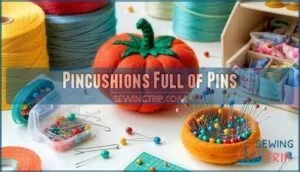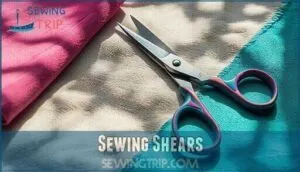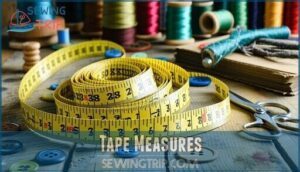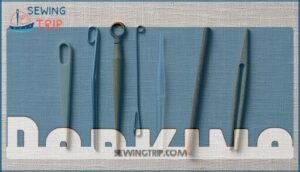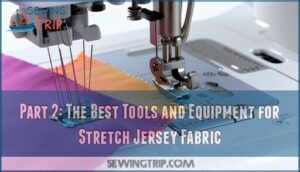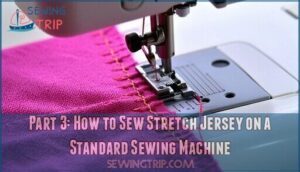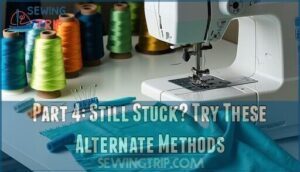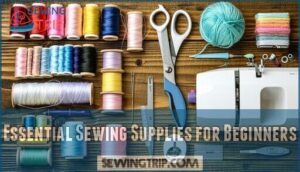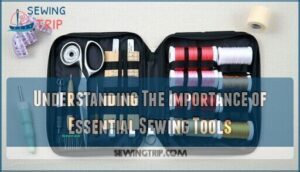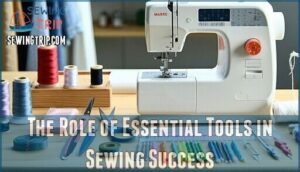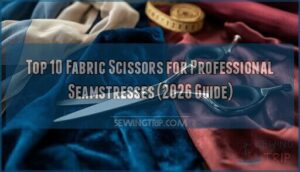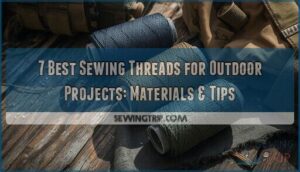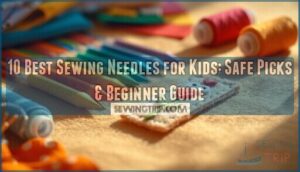This site is supported by our readers. We may earn a commission, at no cost to you, if you purchase through links.
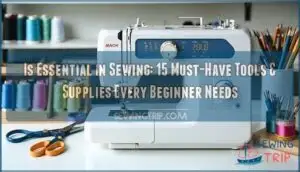 Quality tools are what’s essential in sewing success.
Quality tools are what’s essential in sewing success.
You’ll need sharp fabric scissors, a reliable seam ripper for those inevitable mistakes, and sturdy pins with a good pincushion.
A flexible tape measure, needle threader, and small thread snips round out your basic toolkit.
Don’t forget a quality sewing machine – it’s your workhorse.
These fundamentals transform chaotic fabric scraps into polished projects.
Without proper tools, you’re fighting an uphill battle against frayed edges and crooked seams.
The right equipment doesn’t just make sewing easier; it makes the difference between amateur attempts and professional-looking results that’ll have everyone asking where you bought that gorgeous piece.
Table Of Contents
Key Takeaways
- You’ll need six fundamental tools to avoid frustration: sharp fabric scissors, reliable seam ripper, sturdy pins with pincushion, flexible tape measure, needle threader, and thread snips
- Quality tools directly impact your results – sharp scissors prevent fraying, proper needles avoid skipped stitches, and well-maintained equipment creates professional-looking seams instead of amateur attempts
- Organization and maintenance matter as much as the tools themselves – keep your essentials accessible, store scissors properly, clean equipment regularly, and replace dull blades to maintain precision
- Start with basic, quality pieces before expanding – invest in foundational tools that match your skill level, then gradually add specialized equipment as your confidence and project complexity grow
Must-Have Sewing Tools
You’ll want to grab these six essential tools before starting any sewing project, as they’ll save you from countless frustrations and wonky seams.
Think of them as your sewing survival kit – without these basics, you’re basically trying to build a house with a butter knife and good intentions, which is why having the right tools is crucial for a successful project with wonky seams.
Pincushions Full of Pins
Every sewing project needs a reliable pincushion brimming with various pins within arm’s reach.
Choose from traditional tomato-shaped cushions, magnetic styles, or wrist-worn options for pin organization. Stock yours with straight pins, safety pins, and quilting pins.
Consider exploring different sewing pincushion options for your needs.
A well-organized pincushion transforms chaos into smooth stitching while keeping needle safety paramount in your essential tools collection.
Sewing Shears
Quality fabric scissors make all the difference between clean cuts and frayed disasters.
Sharp blades glide through fabric without snagging or pulling threads. Look for ergonomic shears with comfortable grips that won’t strain your hands during long cutting sessions.
Specialty shears like pinking shears prevent fraying, while bent-handle scissors keep fabric flat.
Proper shear maintenance matters—store them safely, clean after use, and invest in regular shear sharpening. Consider purchasing sewing shears for superior results. These cutting tools deserve respect as your most important sewing investment.
Needle Threaders
Threading needles doesn’t have to be a headache when you’ve got the right needle threader in your toolkit.
These simple sewing tools come in various types – wire loop threaders work best for hand sewing needles, while larger ones handle heavier threads.
Ergonomics matter too; choose one that feels comfortable during extended use.
Finding the right one may require exploring threader tool options.
Threading difficulties vanish when you insert the wire through the needle’s eye, catch your thread, and pull back through.
DIY threaders work in a pinch – try folding paper into a point.
Keep your threader clean with regular maintenance, removing lint buildup for smooth operation every time.
Tape Measures
After threading your needle with ease, you’ll need measuring tape for accurate measurement throughout your sewing journey.
This flexible ruler becomes your best friend when creating perfectly fitted garments and home decor projects.
Your measuring tape helps you capture body measurements, mark measuring hems precisely, and create accurate pattern outlines.
Unlike rigid rulers, this essential tool bends around curves and contours effortlessly.
- Body measurement: Wrap around waist, bust, and hips for custom-fitted clothing
- Pattern sizing: Verify fabric requirements and adjust pattern pieces accordingly
- Seam allowances: Mark consistent distances from edges for professional results
Keep your measuring tape nearby while sewing—you’ll reach for this indispensable tool more often than you’d expect.
Quality sewing tools like flexible rulers make measuring accurately second nature.
Bodkins
When threading elastic through waistband casings, bodkins become your trusty sidekick. These slender, pointed sewing tools guide drawstrings and elastic through narrow channels without the usual wrestling match.
| Bodkin Type | Best For |
|---|---|
| Plastic Bodkin | Thick elastic, delicate fabrics |
| Metal Bodkin | Tightly woven materials, precision work |
| Safety Pin | Emergency alternative, lightweight elastic |
| Paper Clip | Quick fixes, temporary solutions |
| Wooden Bodkin | Hand sewing needles compatibility, gentle handling |
Different Bodkin Types serve specific purposes in your haberdashery collection. Ensuring you have quality sewing tools will improve project accuracy.
Threading Bodkins through tight spaces requires patience, but they’re essential tools for Elastic Insertion tasks. For Casing Creation projects, bodkins prevent elastic from disappearing into fabric tunnels. Bodkin Alternatives like safety pins work when you’re in a pinch.
Seam Rippers
Mistakes happen, and that’s where your trusty seam ripper becomes your best friend. This small but mighty tool quickly removes unwanted stitches without damaging fabric.
When choosing seam ripper types, look for sharp points and comfortable grips. Using seam rippers effectively means working slowly and deliberately to avoid fabric tears.
- Sharp tip precision: Use the pointed end to slice individual threads cleanly
- Round end safety: The ball protects fabric while lifting cut threads
- Proper technique: Always rip following the original stitch direction for easier removal
- Safe storage: Keep blade covers on to maintain sharpness and prevent accidents
While seam ripper alternatives like old credit cards work temporarily, investing in quality sewing tools pays off. For repairing seam rips, patience beats speed every time.
Remember seam ripper safety – store properly and replace dull blades. These essential tools and sewing notions make learning much less frustrating.
Mastering Sewing Stretch Jersey
Working with stretch jersey can feel tricky at first, but it’s actually one of the most rewarding fabrics to master once you know the right techniques.
You’ll discover that this versatile knit fabric opens up a whole world of comfortable, form-fitting garments that move with your body.
Part 1: What is Jersey Fabric?
Jersey fabric transforms sewing projects with its stretchy, body-hugging properties. This knit material drapes beautifully and moves with you, making it perfect for comfortable garments.
Understanding Jersey Knit Types and Fabric Composition helps with fabric selection. Different Stretch Properties affect Garment Applications, while proper Care Instructions guarantee longevity.
A vital aspect is understanding how to adjust tension to prevent puckering.
| Jersey Type | Stretch Direction | Best For |
|---|---|---|
| Single Jersey | Horizontal stretch | T-shirts, dresses |
| Double Jersey | Both directions | Fitted tops, leggings |
| Interlock | Minimal stretch | Structured garments |
| Ponte | Stable stretch | Blazers, pants |
Master these fabric types for successful sewing techniques and garment construction.
Part 2: The Best Tools and Equipment for Stretch Jersey Fabric
When tackling stretch jersey, you’ll need specialized tools that work with the fabric’s unique properties, not against them.
The right equipment transforms a potentially frustrating project into smooth sailing.
- Jersey needles – Ballpoint or stretch needles prevent snags and skipped stitches
- Walking foot – Guarantees even feeding without stretching delicate fabric layers
- Ballpoint pins – Won’t damage stretchy fibers like standard sharp pins do
- Serger settings – Creates professional stretchy seams with differential feed control
For sewing spandex, consider using specialized stretch needles.
Part 3: How to Sew Stretch Jersey on a Standard Sewing Machine
When sewing stretch jersey on a standard sewing machine, start by installing a ballpoint needle to prevent fabric snags and skipped stitches.
Adjust your sewing machine tension to a lower setting—sometimes as low as 1—to accommodate the fabric’s stretch. Select Jersey Stitch Settings like zigzag or stretch stitches rather than straight stitches for flexible seams.
Reduce presser foot pressure through Feed Dog Control to minimize fabric distortion. For Needle Selection, use fresh ballpoint or jersey sewing machine needles specifically designed for knits.
Test your chosen stitch types on fabric scraps first, focusing on Tension Adjustment and Preventing Stretching by guiding—not pulling—the fabric through your machine. Using a narrow zigzag stitch can provide the necessary flexibility and strength for these fabrics.
Part 4: Still Stuck? Try These Alternate Methods
Still struggling with jersey? Don’t throw in the towel!
These troubleshooting techniques can save your project.
Switch to ballpoint needles designed for knits, add tissue paper under seams for stability, or invest in a walking foot.
Adjust your stitch length and tension settings.
For slippery fabrics, try washaway stabilizer underneath.
These creative solutions and method adaptations will transform your sewing experience from frustrating to fantastic.
Essential Sewing Supplies for Beginners
You’ll need a solid foundation of essential tools to start your sewing journey successfully.
These five fundamental supplies will handle most beginner projects and set you up for long-term crafting success.
They are the basis for most beginner sewing projects.
Sewing Machine
Your sewing machine becomes the workhorse of your creative journey, transforming fabric into finished projects with remarkable speed and precision.
Today’s beginner machines offer incredible value, combining essential features with user-friendly operation that’ll have you stitching confidently in no time.
- Brother XM2701: Lightweight, affordable, and packed with features for versatile project handling
- Automatic threading and drop-in bobbins: Simplify setup and reduce frustration during sewing sessions
- Multiple stitch types: Zigzag, straight, and decorative options expand your creative possibilities
When selecting your first machine, prioritize reliability over bells and whistles.
Look for adjustable tension adjustment, various needle selection options, and essential sewing machine accessories like different sewing machine feet.
Regular sewing machine maintenance—cleaning lint and oiling moving parts—keeps your investment running smoothly.
Start with a reputable brand that offers good customer support, then gradually add specialized sewing machine needles and accessories as your skills develop.
Fabric Scissors
Sharp fabric scissors transform your sewing experience from frustrating struggles to smooth precision.
You’ll want dedicated shears with comfortable ergonomic handles that fit your grip perfectly.
Never use these precious tools on paper or anything besides fabric—it dulls the blades faster than you’d imagine.
| Scissors Maintenance | Best Practices |
|---|---|
| Cleaning | Wipe blades after each project |
| Storage | Keep in protective sheaths |
| Sharpening Services | Professional tune-ups yearly |
| Blade Care | Oil pivot points monthly |
| Cutting Techniques | Use full blade length, not tips |
Different fabric types demand specific approaches.
Lightweight silks need gentle pressure, while denim requires confident, decisive cuts.
Quality fabric scissors with proper cutting techniques guarantee clean edges that won’t fray prematurely, making your finished projects look professionally made.
Pinking Shears
While fabric scissors handle large cutting tasks, pinking shears specialize in fray prevention and finishing seams with their distinctive zigzag blade angles.
These specialized sewing tools excel at fabric cutting across various fabric types.
Here’s why you’ll love your pinking shears:
- Stop fabric fraying before it starts with those signature zigzag cuts
- Create stunning decorative edges that add professional flair to any project
- Skip tedious zigzag stitching on curves and tricky corners
- Finish raw edges instantly without additional hemming work
Think of pinking shears as your fabric’s bodyguard—they protect edges while looking good doing it.
Regular shears maintenance keeps those special blades sharp for clean cuts every time.
Small Scissors for Snipping Threads
Picture delicate wisps of thread trailing from your latest masterpiece – that’s where thread snips become your best friend. These specialized sewing tools are precision cutting instruments designed specifically for trimming threads close to fabric without damaging your work.
Thread snip types vary from micro-tip scissors for intricate detail work to curved-blade versions that easily access tight corners. Ergonomic thread snips feature comfortable grips that reduce hand fatigue during extended sewing sessions. Unlike regular scissors, these portable snips offer superior control when you’re working near delicate seams.
Quality thread snips maintain their sharpness longer than generic sewing accessories. Look for stainless steel blades that resist corrosion and stay sharp through countless cuts. Spring-loaded handles automatically reopen after each snip, speeding up your workflow substantially.
Proper snip maintenance involves occasional cleaning and blade protection. To guarantee accurate measurements, consider using fabric marking pens. Store them in a dedicated spot within your sewing kit to prevent dulling. Never use your thread snips on paper or other materials – reserve them exclusively for threads and lightweight fabrics. This simple rule keeps your precision cutting tools performing perfectly for years of successful sewing projects.
Seam Ripper
Every sewist’s toolkit needs a trusty seam ripper—your best friend when things go sideways. This small but mighty tool rescues you from sewing mishaps with surgical precision.
Essential seam ripper uses include:
- Removing incorrect stitches and botched seams
- Taking out temporary basting threads
- Opening buttonholes that went awry
Quality matters here. Choose one with a comfortable grip and sharp point for clean cuts. Different types of rippers handle various sewing equipment needs—from standard models to ergonomic designs.
Master proper ripping techniques by sliding the blade under stitches, not yanking through fabric. When your ripper dulls, replace it immediately to prevent fabric damage. Alternative tools like small scissors work in a pinch, but nothing beats a dedicated seam ripper for repairing mistakes efficiently.
Understanding The Importance of Essential Sewing Tools
Building your sewing toolkit isn’t just about collecting random gadgets—it’s about investing in your creative journey.
Quality sewing tools directly impact your Project Longevity and overall satisfaction.
When you use sharp fabric scissors instead of dull kitchen shears, you’ll notice cleaner cuts and less fabric fraying.
This Precision Matters because it affects how your seams align and how professional your finished pieces look.
Tool Quality also provides an Efficiency Boost that transforms your sewing experience.
High-grade sewing essentials work with you, not against you.
A reliable seam ripper saves time when mistakes happen, while accurate measuring tools prevent costly fabric waste.
These sewing accessories become extensions of your hands as your Skill Development progresses.
Think of essential sewing equipment as your foundation—you wouldn’t build a house on shaky ground.
Quality sewing tools for beginners create confidence, allowing you to focus on learning techniques rather than fighting with inadequate supplies.
This investment pays dividends in every project you complete.
The Role of Essential Tools in Sewing Success
Success in sewing hinges on selecting the right sewing tools that match your project complexity and skill level.
The right tools don’t just make sewing easier—they make it possible.
Quality sewing essentials transform frustrating experiences into enjoyable creative sessions, while poor tools can derail even simple projects.
Consider these key factors when building your toolkit:
- Tool Quality – Sharp scissors and precise measuring tape deliver clean cuts and accurate measurements
- Ergonomics – Comfortable grips reduce hand fatigue during long sewing sessions
- Maintenance Matters – Well-maintained sewing accessories perform consistently and last longer
- Creative Applications – Versatile tools expand your project possibilities beyond basic seams
- Project Complexity – Match tool sophistication to your current skill level and ambitions
Invest wisely in foundational pieces first, then expand your collection as your confidence grows.
Beginners should prioritize acquiring sewing kit essentials to start their sewing journey effectively.
Frequently Asked Questions (FAQs)
What are the essentials of sewing?
You’d think sewing’s rocket science, but it’s surprisingly simple! You’ll need sharp fabric scissors, measuring tape, quality thread, hand needles, machine needles, pins, and seam ripper to start creating.
Why do you need to keep your sewing essentials organized?
Keeping your sewing essentials organized saves time, prevents frustration, and helps you find tools quickly during projects.
You’ll avoid interrupting your creative flow, reduce mistakes from using wrong tools, and maintain better focus on crafting, which ultimately helps in keeping your work organized and complete concepts in mind.
What equipment do you need to learn to sew?
As they say, "well begun is half done" – you’ll need a sewing machine, fabric scissors, measuring tape, hand needles, thread, pins, and an iron to start your sewing journey successfully.
Do you need a sewing machine to learn to sew?
No, you don’t need a sewing machine to learn sewing basics.
Hand sewing teaches fundamental skills like stitching, seam allowances, and fabric handling, building your foundation before advancing to machine work.
Why are sewing needles important?
Sewing needles serve as your fabric’s gateway, creating precise holes for thread to pass through cleanly.
Sharp needles prevent snags and tears, ensuring professional-looking stitches that’ll make your projects shine beautifully.
What do you need to learn to sew?
About 40% of sewers quit within their first year due to overwhelming complexity.
You’ll need basic tools like scissors, measuring tape, needles, and thread, plus fundamental skills including straight stitching, seam allowances, and pressing techniques.
What are the essentials for sewing?
You’ll need a reliable sewing machine, sharp fabric scissors, measuring tape, hand needles, thread in basic colors, pins, seam ripper, and an iron for professional-looking results.
Is sewing an essential skill?
Like knights once mastered swordplay, you’ll find sewing incredibly valuable today.
It empowers you to customize fit, repair clothes sustainably, and express creativity.
All while building patience and practical problem-solving skills for life.
Why is sewing so addictive?
You’ll find yourself hooked because each project teaches you something new, builds confidence, and creates tangible results you can actually use or gift to others.
When you make a mistake in sewing, what is essential?
Don’t panic! You’ll need your seam ripper to carefully undo stitches. Stay patient, assess what went wrong, and remember—even seasoned sewists mess up regularly. It’s part of learning.
Conclusion
Mastering these essential tools is like building a bridge between your creative vision and reality.
Once you’ve assembled your sewing arsenal, what’s essential in sewing becomes second nature.
You’ll find yourself reaching for the right tool instinctively, whether it’s threading a needle or ripping out stubborn seams.
These investments pay dividends in every project you tackle.
Start with the basics, then expand your collection as your skills grow.
Your future self will thank you for investing in quality from the beginning.
- https://winslets.com/blogs/sewing-basics/100-sewing-tools-and-equipment-for-beginner-and-advanced-sewists
- https://theeverydayfarmhouse.com/best-sewing-supplies-for-beginners/
- https://blog.siysewityourself.com/2022/06/10/15-must-have-notionf-for-your-sewing-kit/
- https://www.seamwork.com/creativity-and-mindset/the-8-most-important-sewing-skills-to-learn
- https://www.thesewingroomalameda.com/fashion-studies-blog/2024/1/24/7-compelling-reasons-to-learn-the-craft-of-sewing

